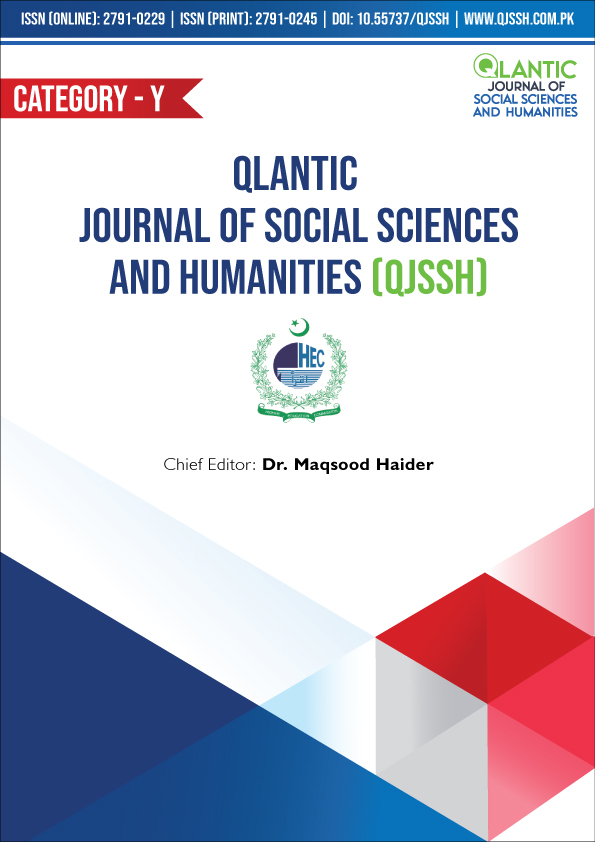Examining Relationship Between Nomophobia and Academic Performance; Moderating Role of Academic Motivation
DOI:
https://doi.org/10.55737/qjssh.vi-i.25324Keywords:
Nomophobia, Perceived Academic Performance, Academic Motivation, Academic PerformanceAbstract
Using internet and electronic gadegets for information, socialization, and gaming purposes has tremendously increased mobile phone dependence among students. This has resulted in the experiences of nomophobia which adversely affects students' academic achievements. However, those who have higher academic motivation can ovrcome their mobile gadget dependence, reduce their nomophobia, and increase their academic performance. The current study has examined the relationship between nomophobia and perceived academic performance while focusing on the moderating role of academic motivation. A sample of 305 students from different colleges and universities was surveyed. The Nomophobia Questionnaire, the Academic Performance Scale, and the Academic Motivation Scale were used to achieve the study objectives. Results revealed a significant negative relationship between nomophobia and academic performance indicating that students having higher levels of nomophobia had perceived their academic performance as lower. Additionally, academic motivation had a positive impact on the perceived academic performance but failed to moderate the relationship between nomophobia and perceived academic performance. Moreover, students who spent more time on their mobile phones reported higher nomophobia. These findings suggest that there might be several other factors associated with perceived academic performance that could reduce the negative effects of nomophobia on perceived academic performance.
References
Abukhanova, A., Almukhambetova, B., Mamekova, A., Spatay, A., & Danikeyeva, A. (2024). Association between nomophobia and learning performance among undergraduate students: The mediating role of depression and anxiety. Frontiers in Education, 9. https://doi.org/10.3389/feduc.2024.1365220
ADEBO, P. (2018). Mobile social media. International Journal of Advanced Research in Computer Science and Software Engineering, 8(3), 8. https://doi.org/10.23956/ijarcsse.v8i3.558
Al Husaini, Y. N. S., & Shukor, N. S. A. (2022). Factors affecting students’ academic performance: A review. Social Science Journal, 12(6), 284-296.
Al-Mamun, F., Mamun, M. A., Prodhan, M. S., Muktarul, M., Griffiths, M. D., Muhit, M., & Sikder, M. T. (2023). Nomophobia among university students: Prevalence, correlates, and the mediating role of smartphone use between Facebook addiction and nomophobia. Heliyon, 9(3), e14284. https://doi.org/10.1016/j.heliyon.2023.e14284
Alwafi, H., Naser, A. Y., Aldhahir, A. M., Fatani, A. I., Alharbi, R. A., Alharbi, K. G., Almutwakkil, B. A., Salawati, E., Ekram, R., Samannodi, M., Almatrafi, M. A., Rammal, W., Assaggaf, H., Qedair, J. T., Al Qurashi, A. A., & Alqurashi, A. (2022). Prevalence and predictors of nomophobia among the general population in two middle eastern countries. BMC Psychiatry, 22(1). https://doi.org/10.1186/s12888-022-04168-8
Amjad, R., & MacLeod, G. (2014). Academic effectiveness of private, public and private–public partnership schools in Pakistan. International Journal of Educational Development, 37, 22-31. https://doi.org/10.1016/j.ijedudev.2014.02.005
Amjid, M., Khan, S., & Tayyab, M. (2023). Comparison of Teaching Learning Environment and Academic Achievement among Public and Private Sectors Secondary Schools. Journal of Contemporary Trends and Issues in Education, 3(1), 36-52. https://doi.org/10.55628/jctie.v3i1.88
Arif, M., Butt, K., Hussain, A., & Asim, M. (2023). Social media use among University students: A review and direction for future research. Pakistan Journal of Information Management and Libraries, 25, 83-108. https://doi.org/10.47657/7303
Atasever, A., Çeli̇K, L., & Eroğlu, Y. (2022). Mediating effect of digital addiction on the relationship between academic motivation and life satisfaction in university students. Participatory Educational Research, 10(1), 17–41. https://doi.org/10.17275/per.23.2.10.1
Awan, K., Saeed, S., & Zafar, N. (2022). Nomophobia, insomnia, academic percentage, and mental health problems in late adolescents in Pakistan. Journal of Research and Reviews in Social Sciences Pakistan, 5(2), 1776–1792. http://journal.kinnaird.edu.pk
Bano, S., & Riaz, M. N. (2023). Moderating role of academic motivation and entitlement between motives of students and academic achievement among university students. Journal of the Pakistan Medical Association, 73(4), 759-762. https://doi.org/10.47391/jpma.01016
Barton, B. A., Adams, K. S., Browne, B. L., & Arrastia-Chisholm, M. C. (2018). The effects of social media usage on attention, motivation, and academic performance. Active Learning in Higher Education, 22(1), 11-22. https://doi.org/10.1177/1469787418782817
Berdida, D. J., & Grande, R. A. (2023). Nursing students’ nomophobia, social media use, attention, motivation, and academic performance: A structural equation modeling approach. Nurse Education in Practice, 70, 103645. https://doi.org/10.1016/j.nepr.2023.103645
Berestova, A., Burdina, G., Lobuteva, L., & Lobuteva, A. (2022). Academic motivation of University students and the factors that influence it in an E-learning environment. Electronic Journal of e-Learning, 20(2), pp201-210. https://doi.org/10.34190/ejel.20.2.2272
Birchmeier, C., Grattan, E., Hornbacher, S., & McGregory, C. (2015). Academic Performance Scale. Academia. https://www.academia.edu
Boumosleh, J. M., & Jaalouk, D. (2017). Depression, anxiety, and smartphone addiction in university students- A cross sectional study. PLOS ONE, 12(8), e0182239. https://doi.org/10.1371/journal.pone.0182239
Bragazzi, N., & Del Puente, G. (2014). A proposal for including nomophobia in the new DSM-V. Psychology Research and Behavior Management, 155. https://doi.org/10.2147/prbm.s41386
Brenner, C. A. (2022). Self-regulated learning, self-determination theory and teacher candidates’ development of competency-based teaching practices. Smart Learning Environments, 9(1). https://doi.org/10.1186/s40561-021-00184-5
Brew, E. A., Nketiah, B., & Koranteng, R. (2021). A literature review of academic performance, an insight into factors and their influences on academic outcomes of students at senior high schools. OALib, 08(06), 1-14. https://doi.org/10.4236/oalib.1107423
Buctot, D. B., Kim, N., & Kim, S. (2021). Personal profiles, family environment, patterns of smartphone use, Nomophobia, and smartphone addiction across low, average, and high perceived academic performance levels among high school students in the Philippines. International Journal of Environmental Research and Public Health, 18(10), 5219. https://doi.org/10.3390/ijerph18105219
Chowdhury, E. K. (2024). Examining the benefits and drawbacks of social media usage on academic performance: A study among university students in Bangladesh. Journal of Research in Innovative Teaching & Learning. https://doi.org/10.1108/JRIT-07-2023-0097
Copaja-Corzo, C., Aragón-Ayala, C. J., & Taype-Rondan, A. (2022). Nomophobia and its associated factors in Peruvian medical students. International Journal of Environmental Research and Public Health, 19(9), 5006. https://doi.org/10.3390/ijerph19095006
De la Fuente, J., Fernández-Cabezas, M., Cambil, M., Vera, M. M., González-Torres, M. C., & Artuch-Garde, R. (2017). Linear relationship between resilience, learning approaches, and coping strategies to predict achievement in undergraduate students. Frontiers in Psychology, 8. https://doi.org/10.3389/fpsyg.2017.01039
Deci, E. L., & Ryan, R. M. (1985). Conceptualizations of intrinsic motivation and self-determination. Intrinsic Motivation and Self-Determination in Human Behavior, 11-40. https://doi.org/10.1007/978-1-4899-2271-7_2
Demirci, K., Akgönül, M., & Akpinar, A. (2015). Relationship of smartphone use severity with sleep quality, depression, and anxiety in university students. Journal of Behavioral Addictions, 4(2), 85-92. https://doi.org/10.1556/2006.4.2015.010
Dennis, J. M., Phinney, J. S., & Chuateco, L. I. (2005). The role of motivation, parental support, and peer support in the academic success of ethnic minority first-generation college students. Journal of College Student Development, 46(3), 223-236. https://doi.org/10.1353/csd.2005.0023
Engida, M. A., Iyasu, A. S., & Fentie, Y. M. (2024). Impact of teaching quality on student achievement: Student evidence. Frontiers in Education, 9. https://doi.org/10.3389/feduc.2024.1367317
Farooq, M., Rizvi, M. A., Wajid, W. A., Ashraf, M., Farooq, M., Javed, H., Sadiq, M. A., Jafar, H. M., Hameed, F., Rizvi, M. A., & Tayyba, A. (2022). Prevalence of Nomophobia and an analysis of its contributing factors in the undergraduate students of Pakistan. Cyberpsychology, Behavior, and Social Networking, 25(2), 147-153. https://doi.org/10.1089/cyber.2021.0148
Gezgin, D. M., Hamutoglu, N. B., Sezen-Gultekin, G., & Ayas, T. (2018). The relationship between Nomophobia and loneliness among Turkish adolescents. International Journal of Research in Education and Science, 4(2), 358-374. https://doi.org/10.21890/ijres.409265
Gonçalves, S., Dias, P., & Correia, A. (2020). Nomophobia and lifestyle: Smartphone use and its relationship to psychopathologies. Computers in Human Behavior Reports, 2, 100025. https://doi.org/10.1016/j.chbr.2020.100025
Gupta, P. K., & Mili, R. (2017). IMPACT OF ACADEMIC MOTIVATION ON ACADEMIC ACHIEVEMENT: A STUDY ON HIGH SCHOOLS STUDENTS. European Journal of Education Studies. https://doi.org/10.46827/ejes.v0i0.547
Gutiérrez-Puertas, L., Márquez-Hernández, V. V., São-Romão-Preto, L., Granados-Gámez, G., Gutiérrez-Puertas, V., & Aguilera-Manrique, G. (2019). Comparative study of nomophobia among Spanish and Portuguese nursing students. Nurse Education in Practice, 34, 79-84. https://doi.org/10.1016/j.nepr.2018.11.010
Hasanein, A. M., & Sobaih, A. E. E. (2023). Drivers and consequences of CHATGPT use in higher education: Key stakeholder perspectives. European Journal of Investigation in Health Psychology and Education, 13(11), 2599–2614. https://doi.org/10.3390/ejihpe13110181
Ibrahim, M. N. (2023). Prevalence of insomnia and its association with academic performance and Nomophobia among Allied health sciences students. Journal of Rehabilitation and Clinical Research (JRCR), 1(2), 32-36. https://doi.org/10.61776/jrcr.v1i2.3035
Iqbal, S., Ashfaq, T., & Moosa, K. (2022). Students' perceived quality of academic programs in higher education institutions: An empirical study. Pakistan Journal of Educational Research, 5(4), 1-22. https://doi.org/10.52337/pjer.v5i4.645
Irna, S. (2020). The effect of smartphone usage on student discipline, motivation and learning achievement. Journal of Physics: Conference Series, 1521(3), 032105. https://doi.org/10.1088/1742 6596/1521/3/032105
Izaguirre, L. A., Rodríguez‐Fernández, A., & Fernández‐Zabala, A. (2022). Perceived academic performance explained by school climate, positive psychological variables and life satisfaction. British Journal of Educational Psychology, 93(1), 318-332. https://doi.org/10.1111/bjep.12557
Javaeed, A., Asghar, A., Allawat, Z., Haider, Q., Mustafa, K. J., & Ghauri, S. K. (2019). Assessment of academic motivation level of Undergraduate medical students of Azad Kashmir, Pakistan. Curēus. https://doi.org/10.7759/cureus.4296
Khan, S., Atta, M., Malik, N. I., & Makhdoom, I. F. (2021). Prevalence and relationship of smartphone addiction, nomophobia, and social anxiety among college and university late adolescents. Ilkogretim Online, 20(5), 3588. https://doi.org/10.17051/ilkonline.2021.05.394
Korat, N. R. (2020). Nomophobic symptoms and depression among adults’ of Rajkot district. International Journal of Indian Psychology, 8(1). https://doi.org/10.25215/0801.013
Kubrusly, M., Silva, P. G. de B., Vasconcelos, G. V. de, Leite, E. D. L. G., Santos, P. de A., & Rocha, H. A. L. (2021). Nomofobia entre discentes de medicina e sua associação com depressão, ansiedade, estresse e rendimento acadêmico. Revista Brasileira de Educação Médica, 45(3). https://doi.org/10.1590/1981-5271v45.3-20200493
Kumar, M., & Bhuyan, S. (2023). Teacher- Student Relationship of University Students in relation to their Academic Achievement. International Research Journal of Modernization in Engineering Technology and Science. https://doi.org/10.56726/irjmets42562
Malik, A., & Rafiq, N. (2016). Exploring the Relationship of Personality, Loneliness, and Online Social Support with Interned Addiction and Procrastination. Pakistan Journal of Psychological Research, 31, 93.
Mohammad Kraishan, S., Aldwecat, S. H. S., Amarneh, B. H., & Al-Majali, M. A. (2024). Prevalence and impact of nomophobia on academic performance among university students: South of Jordan. Migration Letters, 21(3), 178-191. https://migrationletters.com/index.php/ml/article/view/6742
Muhammad, N., Siddique, A., Jabeen, S., & Muhammad Sohail AKhtar. (2023). Academic Motivation and Engagement: A Correlational Study of Students’ Perspective at Secondary School Level. Journal of Social Sciences Review (Print), 3(2), 852–863. https://doi.org/10.54183/jssr.v3i2.315
Naik, B., Rao, R., Verma, M., Singh, C., & Nirala, S. (2023). Internet addiction and nomophobia among medical undergraduates of a tertiary care teaching institute in Patna, Eastern India. Journal of Education and Health Promotion, 12(1), 286. https://doi.org/10.4103/jehp.jehp_1663_22
Narad, A., & Abdullah, B. (2016). Academic performance of senior secondary school students: Influence of parental encouragement and school environment. Rupkatha Journal on Interdisciplinary Studies in Humanities, 8(2), 12-19. https://doi.org/10.21659/rupkatha.v8n2.02
Nawaz, I., Sultana, I., Amjad, M. J., & Shaheen, A. (2017). Measuring the enormity of Nomophobia among youth in Pakistan. Journal of Technology in Behavioral Science, 2(3-4), 149-155. https://doi.org/10.1007/s41347-017-0028-0
Nguyen, T., Nguyen, Q. N., Nguyen, N. P., & Nguyen, U. B. (2024). Smartphone use, nomophobia, and academic achievement in Vietnamese high school students. Computers in Human Behavior Reports, 14, 100418. https://doi.org/10.1016/j.chbr.2024.100418
Niazi, M., Shakeel, S., Saqib, S., Shahid, T. N., Nawadat, K., & Fahim, A. (2021). Association of Nomophobia with decision making of dental students. Pakistan Journal of Medical and Health Sciences, 15(12), 3918-3920. https://doi.org/10.53350/pjmhs2115123918
Nikolopoulou, K. (2022). Students’ Mobile Phone Practices for Academic Purposes: Strengthening Post-Pandemic University Digitalization. Sustainability, 14(22), 14958. https://doi.org/10.3390/su142214958
Nisar, N. (2018). Students’ Attitude towards the Use of Mobile Telephone Technology in Distance Education. Pakistan Journal of Distance and Online Learning, 4(2), 195–212.
O’Hare, E. (2023). The relationship between nomophobia and: Age, procrastination and loneliness within an Irish population (Undergraduate thesis, National College of Ireland). NORMA eResearch NCI . https://norma.ncirl.ie/6716/1/ellenohare.pdf
Okmi, M., Por, L. Y., Ang, T. F., & Ku, C. S. (2023). Mobile phone data: A survey of techniques, features, and applications. Sensors, 23(2), 908. https://doi.org/10.3390/s23020908
Oraison, H., & Wilson, B. (2024). The relationship between Nomophobia, addiction, and distraction. Journal of Technology in Behavioral Science, 9(4), 745-751. https://doi.org/10.1007/s41347-024-00392-z
Paterna, A., Alcaraz-Ibáñez, M., Aguilar-Parra, J. M., Salavera, C., Demetrovics, Z., & Griffiths, M. D. (2024). Problematic smartphone use and academic achievement: A systematic review and meta-analysis. Journal of Behavioral Addictions, 13(2), 313-326. https://doi.org/10.1556/2006.2024.00014
Persky, A. M., Lee, E., & Schlesselman, L. S. (2020). Perception of learning versus performance as outcome measures of educational research. American Journal of Pharmaceutical Education, 84(7), ajpe7782. https://doi.org/10.5688/ajpe7782
Pinquart, M., & Ebeling, M. (2020). Students’ expected and actual academic achievement – A meta-analysis. International Journal of Educational Research, 100, 101524. https://doi.org/10.1016/j.ijer.2019.101524
Prasad, M. (2017). Nomophobia: A cross-sectional study to assess mobile phone usage among dental students. JOURNAL OF CLINICAL AND DIAGNOSTIC RESEARCH. https://doi.org/10.7860/jcdr/2017/20858.9341
Rugai, J., & Hamiliton-Ekeke, J-T. (2016). A review of digital addiction: A call for safety education. Journal of Education and e-Learning Research, 3(1), 17-22. https://doi.org/10.20448/journal.509/2016.3.1/509.1.17.22
Samaha, M., & Hawi, N. S. (2016). Relationships among smartphone addiction, stress, academic performance, and satisfaction with life. Computers in Human Behavior, 57, 321-325. https://doi.org/10.1016/j.chb.2015.12.045
Schwaiger, E., & Tahir, R. (2020). Nomophobia and its predictors in undergraduate students of Lahore, Pakistan. Heliyon, 6(9), e04837. https://doi.org/10.1016/j.heliyon.2020.e04837
Seo, D. G., Park, Y., Kim, M. K., & Park, J. (2016). Mobile phone dependency and its impacts on adolescents’ social and academic behaviors. Computers in Human Behavior, 63, 282-292. https://doi.org/10.1016/j.chb.2016.05.026
Sit, C. H., Braman, O. R., Kerr, J. H., & Lindner, K. J. (2011). Motivational style and actual and perceived academic performance of secondary school students in Hong Kong. School Psychology International, 34(1), 17-32. https://doi.org/10.1177/0143034311426943
Soleymani, M., Daei, A., & Ashrafi-Rizi, H. (2019). Nomophobia and health hazards: Smartphone use and addiction among university students. International Journal of Preventive Medicine, 10(1), 202. https://doi.org/10.4103/ijpvm.ijpvm_184_19
Tamizhkumaran, J., Sabar, R., Manesh, P., & Ramajayan, P. (2016). A study on usage of e-Commerce through cell phones by college students. Oriental journal of computer science and technology, 9(1), 46-51. https://doi.org/10.13005/ojcst/901.09
Tran, D. (2016). Classifying Nomophobia as smart-phone addiction disorder. UC Merced Undergraduate Research Journal, 9(1). https://doi.org/10.5070/m491033274
Vagka, E., Gnardellis, C., Lagiou, A., & Notara, V. (2023). Nomophobia and self-esteem: A cross sectional study in Greek University students. International Journal of Environmental Research and Public Health, 20(4), 2929. https://doi.org/10.3390/ijerph20042929
Vallerand, R. J., Pelletier, L. G., Blais, M. R., Brière, N. M., Senécal, C. B., & Vallières, É. F. (1992). The Academic Motivation Scale: A measure of intrinsic, extrinsic, and amotivation in education. Educational and Psychological Measurement, 52(4), 1003–1017. https://doi.org/10.1177/0013164492052004025
Veerapu, N., Baer Philip, R. K., Vasireddy, H., Gurrala, S., & Kanna, S. T. (2019). A study on nomophobia and its correlation with sleeping difficulty and anxiety among medical students in a medical college, Telangana. International Journal Of Community Medicine And Public Health, 6(5), 2074. https://doi.org/10.18203/2394-6040.ijcmph20191821
Workman, J., & Heyder, A. (2020). Gender achievement gaps: The role of social costs to trying hard in high school. Social Psychology of Education, 23(6), 1407-1427. https://doi.org/10.1007/s11218-020-09588-6
Yildirim, C., & Correia, A. (2015). Exploring the dimensions of nomophobia: Development and validation of a self-reported questionnaire. Computers in Human Behavior, 49, 130-137. https://doi.org/10.1016/j.chb.2015.02.059
Downloads
Published
Issue
Section
License
Copyright (c) 2025 Fatima Sattar, Dr. Nasreen Rafique

This work is licensed under a Creative Commons Attribution-NonCommercial 4.0 International License.





